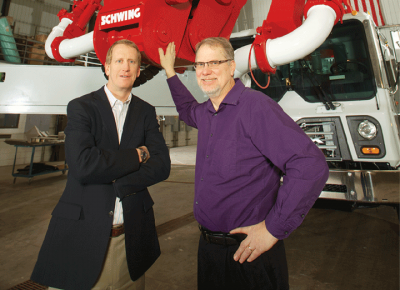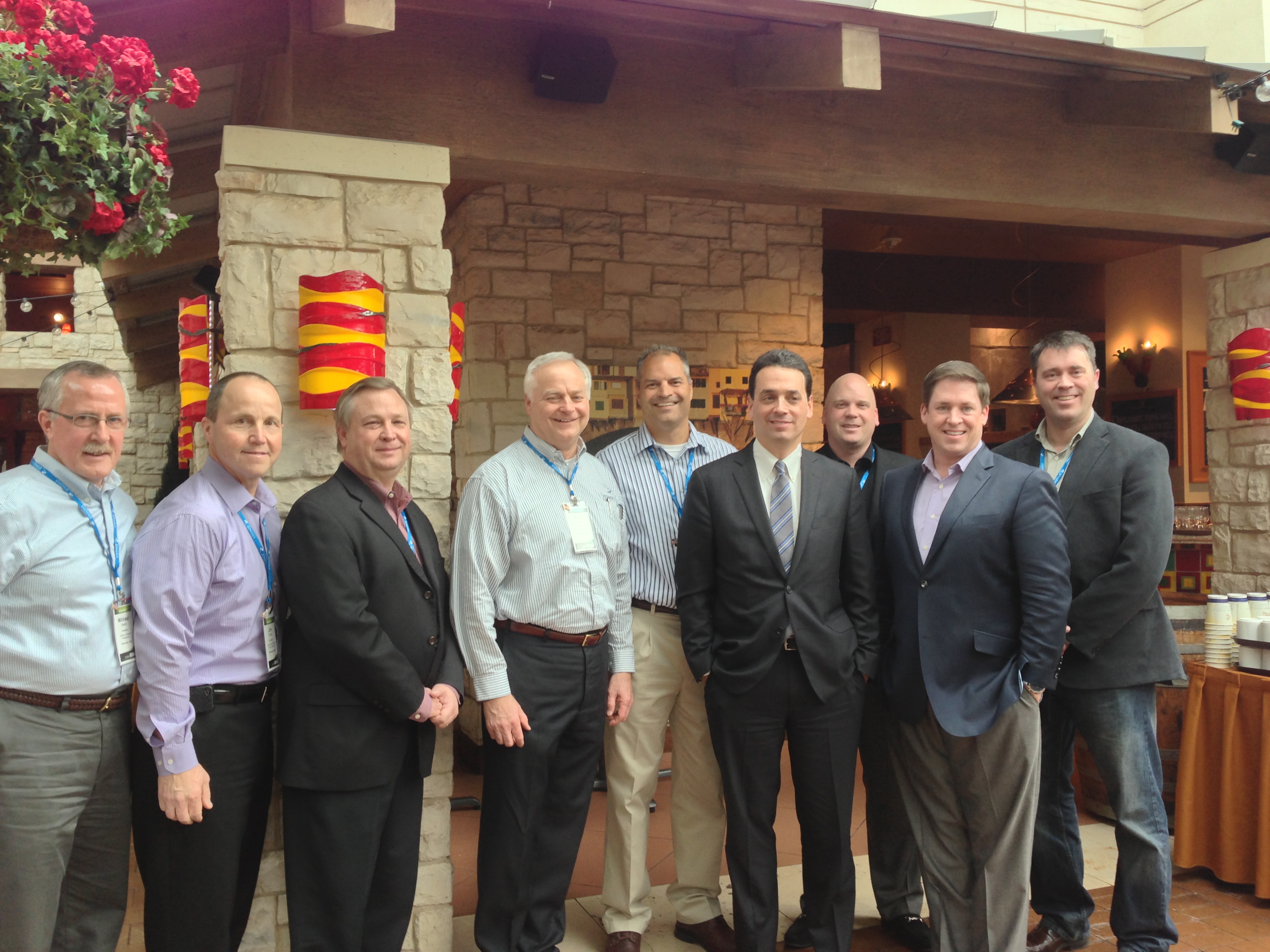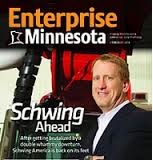Leadership Catalyst Blog
Business Leadership Lessons from Sir Ernest Shackleton and Antarctic Mike
All Blog Posts / 25.04.2016
Leadership can drive an organization to greatness or it can allow it to slowly crumble and die. We tend to attribute success to the hard work of an individual, but in reality it is the collective work of the team that allows a company to achieve great things. Chief Executives must make sure that they have the right people in the right roles to order to achieve the best possible results.
In order to really illustrate this concept for my Vistage members, I brought in Mike Pierce to speak to the business leadership lessons that we can all learn from Sir Ernest Shackleton.
 Shackleton is best known for saving the lives of his entire crew when disaster struck and their ship named the Endurance became trapped in pack ice and was slowly crushed before the party could make it to land. The crew escaped by camping on the sea ice until it melted and then launching the lifeboats to reach first Elephant Island and then ultimately sending an advanced crew to the inhabited island of South Georgia via a stormy ocean voyage of 720 nautical miles. This was Shackleton’s most famous exploit as he then had to return to Elephant Island to rescue the remainder of his crew.
Shackleton is best known for saving the lives of his entire crew when disaster struck and their ship named the Endurance became trapped in pack ice and was slowly crushed before the party could make it to land. The crew escaped by camping on the sea ice until it melted and then launching the lifeboats to reach first Elephant Island and then ultimately sending an advanced crew to the inhabited island of South Georgia via a stormy ocean voyage of 720 nautical miles. This was Shackleton’s most famous exploit as he then had to return to Elephant Island to rescue the remainder of his crew.
Remarkably Shackleton did not lose a single man during this brutal 2-year ordeal in the harshest conditions on the planet. Shackleton knew that he could trust his crew to deliver in their roles, and because of this and his leadership, everyone made it home safely. He knew that his team would preserver because the right men were in the right roles.
“Antarctic Mike” applies Shackleton’s lessons, along with his own experience endurance racing in the same arctic climate, directly to business leadership and helping Vistage owners ensure that they have the right team in place. My Vistage members came away with tangible insights that will help them bring their teams to the next level.
next level.
One of the biggest lessons was how to recruit the right people to join you. Many have seen the following ad that Shackleton allegedly placed in the London times to recruit his team, and generated over 5000 applications.
Antarctic Mike helped one of my members create a video version for his company in about 5 minutes. He asked him to tell a few customer success stories, and then we shot this short video that a person could put on their company website or LinkedIn.
Take less than 5 minutes and watch it for a clever low cost way to attract the right people to your organization.
Read More >>
New Ammunition in the Twin Cities War for Talent
All Blog Posts, Talent Acquisition, Talent Management / 10.03.2015
For decades recruiters have known that it is really hard to get people to move to the twin cities but that once they do it’s impossible to get them to leave. An article in the March 2015 issue of the Atlantic entitled “The Miracle of Minneapolis” penned by Derek Thompson highlights a compelling economic reason behind this adage: no other city mixes affordability, opportunity, and wealth so well.
Minneapolis – St. Paul was one of only three major metro areas to be on two top 10 economic lists that recently came out. The first is a Trulia study that looked at homeowners’ monthly payments in each city relative to the areas median income. The second a Harvard-Berkeley study examining which cities have the highest intergenerational mobility. Many metropolitan areas seem to have caused a trap for their younger residents in which they cannot afford housing and find a job that positions them well for the future. The Twin Cities seems to have realized both affordable housing and upward job mobility.
Other top ten lists that the Twin Cities makes such as the most bike friendly city, Money’s best place to live, and most fit city are just icing on the cake. The fact that young families can come here for great careers and affordable housing is very compelling value proposition for millennials and this article is a great arrow in your quiver for attracting top talent.
How has the Twin Cities done this and continued to make its mark as a strong business friendly region? According to Thompson, “The Twin Cities’ housing and tax-sharing policies have resulted in lots of good neighborhoods with good schools that are affordable for young graduates and remain nice to live in even as their paychecks rise. This, in turn, has nurtured a deep bench of 30- and 40-something managers, who support the growth of large companies, and whose taxes flow to poorer neighborhoods, where families have relatively good odds of moving into the middle class.”
A fact often touted in the region is that the Twin Cities has more Fortune 500 companies per capita than any other metropolitan area. One strong reason for this is the deep blend of 30 and 40 something talented middle managers that help build and grow those companies.
As you recruit out of state talent for your business, let them know that the Twin Cities, along with your company, is a place that grows, fosters and retains talent like no place else.
Read More >>
Women are now fairly well represented in the corporate middle management ranks, but there is still a glaring gap when it comes to women in top business leadership roles. One of the most frequent reasons cited is that women hit the “pause button” on their career advancement while they focus more of their energy on raising their families. While that is true for many, I’d like to explore a few of the theories regarding why there are not more women at the top and what it would take to change the paradigm.
In a TED talk entitled “The Career Advice you Probably Didn’t Get,” leadership expert Susan Colantuono contrasts the development plans of male vs female middle managers who are being prepared to take the next step in their career. A key difference that she points out is that men are being coached and trained on how to run the business (Strategic, Financial and Business Acumen) while women are being coached and trained on leadership and interpersonal skills. Leadership and interpersonal skills are important, particularly at the middle management level, but they are not enough for success at the top of the organization.
Colantuono defines strategic, financial and business acumen as “the skill set that has to do with understanding where the organization is going, what its strategy is, what financial targets it has in place, and understanding your role in moving the organization forward.” It is assumed that anyone in the running for a top management role embodies this skill set, but Colantuano points to this critical arena as the missing 33 percent of the career success equation for women. Her argument is not that women aren’t capable of excelling at strategic, financial and business acumen, but rather that the career advice and coaching that women are being given does not emphasize the importance of boldly and consistently demonstrating mastery of this essential skill set. Colantuono encourages women to seek out opportunities to showcase their strategic, financial and business acumen in their roles and to highlight these accomplishments when being considered for advancement opportunities.
Well known TV news personalities Claire Shipman and Katty Kay wrote an article in The Atlantic called The Confidence Gap addressing the disparity in career success between genders. They argue that confidence matters as much as competence in career advancement, and they point to evidence that suggests women are generally less self-assured than men. The authors highlight examples of extremely talented and credentialed famous women who despite their success, exhibit self-doubt when reminiscing about key moments in their careers. Shipman and Kay believe that the way for women to become more confident is to stop thinking so much and just act, a thought and behavior pattern which will become more ingrained over time with neuro plasticity.
I have a slightly different interpretation of what Shipman and Kay label “The Confidence Gap”. The Atlantic article talks about how women often lack the confidence to put themselves in risky or stretch business leadership roles. The authors label it as self-confidence, but to me it seems more like women holding themselves to a higher standard than men. By that I mean that in some cases, women seem to be more literal when assessing themselves against posted job requirements. A man may look at a list of job requirements and confidently apply if he meets half of them — An equally competent woman may be more likely to feel that she has to have all of the boxes checked to apply and be successful, which may not be the case.
Closing the Gender Gap
Organizations, leaders, and women need to understand that the Critical Success Factors for advancing to top executive positions are different than those required for excelling in middle management positions. The old adage that “What got you here won’t get you there” is especially true for making it to the top of organizations. Here are three ways we can help close the gender gap.
- Make sure the development plans of high performing women with high potential focus on building strategic, financial, and business acumen.
- Encourage high potential women to post for internal positions that they view as a stretch for themselves, even when they feel they don’t meet all of the requirements.
- Place high potential women in Vistage Private Advisory Boards. Investing one day a month with talented men and women from other companies to work “on the business” rather than just working “in the business” will not only improve their strategic and business acumen, it will increase their confidence and help them become better leaders, make better decisions, and get better results.
As a Vistage Chair, I am deeply committed to helping close the gender gap at the top. That is why my Vistage practice has more women members than any other chair practice in town, and why I am actively recruiting and mentoring women to become Vistage Chairs. If you would like to join me as a member or a fellow chair, please call me at 612.877.1234 or email me at Brian.Davis@vistagechair.com
Read More >>
BRIC Countries Might Fall Short on Their Vision for Economic Growth
All Blog Posts, Business, Change, Human Capital, Strategy / 05.05.2014
In my last post, I summarized a great presentation from Vistage Speaker Herb Meyer about the dramatic global drop in birthrates and the implications for businesses in this country. In this post, I will be summarizing Herb’s comments and will add my own conclusions on the “BRIC” countries (Brazil, Russia, India, and China) that have often been cited as the emerging markets that will drive the global economy.
Brazil –Brazil is a real bright spot amongst the BRICs in that the country has a healthy birthrate of over 2.1, modernization is accelerating, and the middle class is growing by 10 to 20 million people per year. While you need Portuguese speaking resources to do business in Brazil, it is a great market to go after with existing US products and services tailored to the specific market preferences.
Russia – Russia is in trouble with a low birthrate of 1.4 and a rapidly aging population that lacks young people to replace the economic output of the baby boomers. The average Russian woman has had 6 abortions, which further reduces fertility rates. A couple of years ago, one of Russia’s provinces attempted to address the birth rate problem by declaring September 12th as “The Day of Conception” — closing its businesses at noon so workers could go home and “make another patriot” for Russia. A few years later, September 12th was proclaimed a national holiday called “The Day of Marital Contact. ” So far we haven’t seen a big spike in June birthrates. Russia has a lot of wealth coming from the energy sector, but their overall economy is not particularly diverse. Russia does not have a large growing middle class to whom U.S. products and services can be marketed.
India – India is the country to watch out for. India’s birthrate is 2.8 and significant portions of the population are well educated and speak English. Herb thinks India will blow past China in terms of economic growth because the country has a gigantic middle class society and the next generation will be even larger while China’s will be getting smaller.
India is not without problems. India has a terrible power grid, the roads are bad, and other facets of the country’s infrastructure are poor. India (and China) also has a huge gender imbalance because of their culture’s strong preference for boys. Statistically, on a global basis, the ratio of boy babies to girl babies is 1.03. In India and China, with the ability to now determine gender in the womb, that ratio is 1.18. In some provinces it is as high as 1.3. This means is that there are 100 million boys growing up in India and China that will never find wives. Both countries have now made it a crime for an obstetrician to disclose the sex of an unborn child, and they are closing down the sonogram clinics that have proliferated in local strip malls.
These actions have not eradicated the problem in India. Mohammad Hamid Ansari (the former President of India) recently disclosed that since making it a crime to disclose the sex of an unborn child, over 7,000 newborn girls are being murdered by their own parents every day. India has set up a network of refuges where parents can now drop off their newborn daughters rather than killing them in hopes of addressing this problem.
China – What China has done in the last couple of decades to bring its people out of poverty is nothing short of amazing, but the country has hit an economic wall. The value proposition that has driven China’s growth is twofold: China makes things happen and they provide cheap labor.
Before, China could put up a new factory in 6 months whereas in the U.S. it could take 5 years to do an environmental impact statement. China simply relocated the peasants who were in the way. It is more difficult to do that to the educated middle class. The level of unrest and protest in China today is greater than it was in the Soviet Union just before the fall of the Iron Curtain. China can’t make things happen nearly as quickly as they used to.
Cheap labor is also going away. China has had a 1 child per couple policy for decades and consequently its birth rate is at 1.1 and it is the most rapidly aging large country on earth. For the first time in history, the Chinese workforce declined last year, and scarcer labor is dramatically increasing labor costs. American countries are taking their manufacturing to cheaper labor sources such as South Vietnam, Bangladesh, and Burma, or even bringing it back to the US.
Affluent Chinese are starting to buy up real estate from Seattle to San Diego as a place to go if the situation in China deteriorates beyond their comfort. Herb feels another part of China’s contingency plan is to send their kids to American schools so that if they need to leave China, they can come into the US under their kids’ student visas. This partially accounts for the large increase in Chinese students in American universities and even high schools.
In China, the gender gap because of the cultural preference for boys is expected to be about 200 million men by 2015. An entire industry is springing up to take planeloads of Chinese men to Ho Chi Min City, Rangoon and other Asian cities to meet potential wives. Aging parents are driving this trend because in most Asian cultures, it is the daughters and daughter-in-laws who look after the elderly. In China there are 165 million elderly people with no pensions, no health insurance and no daughters. By 2025 there will be 250 million old people in China. This is why China is changing the one child per family law, but it will take decades to see a difference. China, in Herb’s opinion, will not be taking over the world.

2010 BRIC Summit – The global excitement about the BRIC economic growth potential has faded since the summit.
Bottom line: Brazil and India, with their healthy birthrates and burgeoning middle class populations, will be fantastic markets for American products for decades to come. Continue to market to China’s enormous middle class, but recognize that it will be shrinking. Demand for products and services to accommodate the needs of its rapidly aging population will be exploding, if they can find a way to pay for it. Russia does not appear to be a great new market for American countries given its low birth rate and rapidly aging population.
Many thanks to Herb Meyer for sharing his knowledge with my Minnesota Vistage Groups. Herb’s opinions are based on statistics from the World Health Organization and backed by a decorated career within the US Intelligence community. I believe they are very relevant to any company considering doing business in BRIC countries.
Read More >>
Global Macro Economic Trends that will Impact your Twin Cities Business
All Blog Posts, Business, Change, Strategy / 02.04.2014
Vistage Chairs bring in a wide range of experts to address our CEO and Executive Peer Groups in Minneapolis every month. Our goal as Vistage Chairs is to increase the effectiveness of CEOs, and one way we do this is by bringing in a speaker on a very specific topic such as how to attract and hire top talent. We will also, bring in speakers who will help our Vistage members take a longer, big picture view of their businesses. In these instances, we encourage executives to look up and scan the radar for what they will be facing in the years to come in addition to focusing on the short-term turbulence they are experiencing.
Herb Meyer, the former senior CIA executive in the Reagan Administration was one such speaker. Since leaving The Agency, Herb has applied his intelligence gathering skills to collecting important data on economic, social, political, and population trends that will dramatically impact our businesses.
Herb presented three megatrends to watch out for and their implications for growing your business.
1. The world is becoming modernized. Technology is sweeping the planet at an amazing rate. Cell phones, the internet, social media, TV, and satellites are connecting people to what is happening throughout the world. Young people throughout the world now have cell phones, and Ipads and can download books, movies, TV shows, and on-line courses from anywhere. Agricultural breakthroughs mean that for the first time in world history, very few people are starving in the “Modern World”, and a major problem for poor people in these countries is obesity.
2. The world is becoming rich. Not only are Millionaires multiplying all over the globe, 50 – 100 million people are coming out of poverty every year. (Non-poverty is defined as having enough to eat, children being inoculated, at least 1 parent working, and having some disposable income.) This means the creation of a large middle class, with 50 – 100 million new customers every year who want the modern conveniences they see on TV and online. The emerging middle class may not be located where we would like them to be, so our challenge is to innovate clever, inexpensive, and green products to serve them.
3. The modern world is becoming old. Populations throughout the world are aging at an alarming rate at the same time as birth rates are plunging. Let’s look at the statistics:
A birthrate of 2.1 births per female is needed to sustain a population, and when birthrates dip consistently below 1.3, a population is on a suicide trajectory. In Europe, the average birthrate is 1.5, and the modern countries that are aging the fastest are Germany, Italy and Spain, all of which have birthrates at or below the 1.3 threshold. In Germany, 30% of all women and 40% of all college educated women are childless. If nothing changes, by 2040, 61% of their population will be over the age of 55. In Italy and Spain the birthrate is at 1.2 and heading for 1.1, and in 20 years they will lose 20% of their workforce. The story is the same in many Asian countries, including Japan, China, and Singapore. In Japan the birthrate is also 1.3, but the population is aging faster. In 20 years, 1 of 5 of their people will be over 70 years old, and in 30 years, the Japanese population will shrink by 60-70 million.. The population is literally dying out, and the people will not tolerate immigration to replace their young people.
In North America, the U.S birthrate is 2.1, (the Anglo birth rate is 1.8 and the Hispanic birthrate is 3.2) and in Canada the birthrate is at 1.5. Finally the birthrate in Mexico is slowing but it is still a healthy 2.6 – 2.7, which means a huge emerging middle class.
By far, the fastest growing populations are in the Muslim world, where birthrates range from 2.6 to 6.8. Two notable exceptions are Turkey and Iran, where birthrates are plummeting.
The implication is that there is a huge growing market for products and services for an aging population with fewer and fewer young people to support them. In Japan, for the first time in history, adult diapers are outselling baby diapers, and a company has invented a robot for bathing people. In Germany, BMW has built a new plant designed for older workers – brighter lighting, non-slip floors and new tooling that requires less physical strength. In Canada, homes are being retrofitted with colored strips across steps and shower ledges to help the elderly with failing depth perception see them and avoid debilitating falls in the home that often result in broken hips.
One of my Minneapolis Vistage members, who manufacturers high pressure hoses for filling industrial gas and oxygen bottles, is seeing a huge increase in demand in the home oxygen tank market. There is huge growth ahead for businesses that figure out how to better serve the wealthy aging population with their existing and new products and services.
So what are these huge business growth opportunities?
1. Look for better ways to meet the needs of an aging world population with fewer young people to take care of them.
2. Adapt your products and services to meet the needs of the 50 – 100 million new customers in the emerging global middle class through the prism of clever, inexpensive and green.
3. As one billion people cross the poverty line in the next couple of decades, there will be tremendous opportunity in the areas of energy, food (especially protein), infrastructure, education, and entertainment. Coincidentally, these are 6 industries in which the U.S. leads the world.
So what about Brazil, Russia, India, and China? Next week’s post will outline the unique challenges and opportunities facing these countries, and why China and Russia are hitting the wall.
Read More >>
Schwing USA charges back – 10 Lessons for leveraging Chapter 11
All Blog Posts, Change, Strategy / 19.03.2014
A hallmark of an effective CEO Peer Group is having members with a diverse set of experiences. A CEO mix featuring a variety of industries, company sizes, and life cycle maturity stages creates a brilliant wealth of knowledge that members can draw on to assist in whatever challenges they are currently facing. As some Vistage members have quipped, it’s nice to have the opportunity to learn from someone else’s mistakes rather than to make them all yourself.
My Minneapolis Vistage groups include several Fast50 members, a Power50 member, the 2013 Manufacturer of the Year and a perennial “Best Place to Work” winner. CEOs are going to have a lot of ups and downs in their careers just like anyone else, and CEOs need a forumthat can help us through the bad times as well as the good. Our CEO Advisory Board is fortunate to include Brian Hazeltine, CEO of Schwing America, who was featured last month on the cover of Enterprise Minnesota for leading his company back from the brink of financial ruin.
Read Schwing Ahead in the February issue of Enterprise Minnesota® magazine.
As Lynn Shelton, Enterprise Minnesota’s Director of Marketing & Communications, writes in their February 21,2014 e-Trends newsletter:
“In September 2009, just two weeks after taking over as CEO, Hazelton brought the company into Chapter 11 bankruptcy protection, just one more move in what our profile called “an almost surreal litany of recession-related poor timing and bad luck that forced the nation’s leading manufacturer of concrete pumps to spend more than four years in a corporate bob and weave,” waiting for the housing industry to bounce back.”
During the housing boom ten years ago Schwing was racing to keep up with demand. At its peak, Schwing grew to 680 employees and ran its 400,000 square-foot facility in White Bear Township 24/7. When the construction industry bottomed out, Schwing had to lay off close to 600 employees and close its in-house paint operation, welding shop and fabrication facility. The story of how Hazelton and his team nimbly managed through, creatively leveraging the Schwing brand and keeping close to its customers (who were also enduring a difficult time) is an inspiration.
Here are few key lessons Brian Hazelton of my Minnesota Vistage group can teach us about surviving a “perfect storm” and repositioning his company to thrive and double next year.
1) Believe in your product strongly enough to fight for it even when the universe seems to be turning against you
2) Beware of unrelated but compounding converging trends
3) When there is a will there is a way – the drive to survive can move mountains
4) Be willing to take on multiple jobs when times are tough
5) Don’t be afraid to reinvent yourself
6) While Chapter 11 is nobody’s first choice, it can be the best strategic option when you are not left with many paths forward
7) Don’t forget about your customers even when they aren’t buying
8) Help your customers sell your product
9) If you don’t tell your story when times are tough, somebody else will and odds are you won’t like their version as well
10) Paying it forward can bring about payback – loyalty is a form of Karma
Read More >>
Leadership Lessons From a 4 Year Old
All Blog Posts, Coaching, Motivation / 05.03.2014
We all need a little inspiration sometimes, and my inspiration today came from the story of an amazing 4 year old in Minnesota who started an outreach that has raised almost $20,000.
To kick off my monthly Vistage Executive Peer Group meetings, I often start by having members mention a business and personal highlight for the month. This serves to reconnect everyone and helps members transition to a day of working “ON’ the business rather than working “IN” the business. Last week Jim Glomstad, General Manager of SporTech, mentioned that Valentines day was a pretty big deal for his family because of his daughter Carly.
When Carly was four, she read a book about a girl that loved Valentine’s day so much she spent days making Valentine cards and goody bags and delivered them to everyone in town via her little red wagon. Carly loved the idea of doing something that would make many people feel special, and she decided to imitate her storybook hero in real life.
Carly raised $450 in her first year which allowed her to distribute 125 goody bags to kids at a crisis nursery and seniors at assisted living residences – people who she thought might need to feel special. That was 6 years ago, and she has expanded her outreach every year. This year she raised nearly $5,000 and delivered 500 goodie bags and cards while also funding a kids connection scholarship and donating to the crisis nursery.
She has her own website, (carlyvalentine.com) and last year she was featured on Kare11. She has raised almost $20,000 over the last 6 years.
Here are some leadership lessons I think we can all learn from this 4 year old:
1. Communicate a compelling vision – Carly wasn’t content to deliver a few goodie bags on her own street. She wanted to cheer up kids who were sick and seniors who may not get any visitors.
2. Go all in. Carly was willing to invest her life savings ($48.76 from her piggy bank) to make her vision a reality.
3. Create a vision larger than yourself. Carly inspired her parents, her family, her kindergarten class, and her girl scout troop to join her in her mission.
4. Follow your passion. Carly truly loves making people feel special, which fuels her willingness to do whatever it takes to get the job done and grow her outreach every year.
5. Have great mentors and a strong support system. Carly couldn’t have done this without the support and coaching of her parents, Jim and Tina Glomstad.
Thank you to the Glomstad family for being great role models and an inspiration to us all!
Read More >>
5 Keys to Overcoming the Challenges of Discontinuous Innovation
All Blog Posts, Change, Vistage Peer Groups / 20.02.2014
The past decade is littered with cases of companies who were on top of their industry one year and then suddenly found themselves struggling to stay alive. Blackberry, Borders, and Blockbuster are three that come immediately to mind. When you read about them in the media or in HBR case studies, it is hard to fathom how they missed the new technology that put them on life support, if not out of business. The phrase “discontinuous innovation” refers to a paradigm shift in technology and/or the market structure of an industry. We can learn a lot from the examples of CEOs who have successfully navigated these disruptive changes.
Minneapolis Vistage member Jay Coughlan offers some insights into why change and organizational transformation is so difficult. He has led his company, XRS through 2 major transformations since 2007, and his story is summarized in a recent Minneapolis Star Tribune article. Below is the quote from the article that provides the background story.
“In 2009 the company, then called Xata, acquired Toronto-based Turnpike Global Technologies, which provided a trucking compliance solution that ran through a handheld device. Truckers and their companies must comply with myriad regulations, from logging hours driven and duty status to tracking state fuel taxes. The XRS service also helps improve performance by keeping track of maintenance schedules, fuel economy and more.
That $20 million acquisition would be the foundation of a complete shift in the company’s approach to providing logistics for the trucking industry. Xata used to be primarily a hardware company that installed a communications dome on top of truck’s cab and then tore apart the dashboard for a four-hour installation of a fixed-panel display and keyboard.
Now, with its mobile technology, it takes about 10 minutes to connect its XRS relay device and sync it with a wide variety of Android and Windows Mobile smartphones, rugged handheld devices and tablet computers that will automatically transmit vehicle and operator data directly to a management dashboard in the cloud. “
In hindsight, this migration from hardware to mobile technology seems like a no brainer, but with discontinuous innovation, there were three powerful stakeholders that made such a transformation almost impossible.
Existing customers – XRS had a large customer base on their legacy hardware with huge sunk costs who wanted them to continue to support that system. They are less than sympathetic to the need for XRS to shift resources from supporting their legacy systems to the development of the new technology.
Shareholders and Investors – Migrating to mobile required a change in business models from a large upfront equipment sale and installation to a subscription model with no upfront revenues. Moving from one to the other means a huge decline in revenues and profits over a year or more, which translates to meager cash flow, and short term losses. Even when you forecast it on paper, it is difficult to maintain the commitment of your board and investors when you are in the middle of it, especially when there is no guarantee of long term success.
Company Leaders and Employees – Migrating from a hardware solution to a software solution, to ultimately a mobile solution required totally different skillsets in engineering, software development, and sales and was only possible with a 70% turnover of employees. Without a clear vision and a burning platform for change it is impossible to drive the changes required to support this kind of transformation.
Based on many monthly coaching sessions and CEO peer meetings with Jay, I have identified 5 Keys that enabled XRS to overcome stakeholder resistance.
- Communicating a compelling vision of the power of being a first mover in his industry with mobile technology. The message needs to be simple and re-communicated over and over to remind people where we are going.
- Creating a “burning platform” (sense of urgency) around how iPads, tablets, and smart phones were discontinuous innovations that could render their current system obsolete – XRS needed to make the leap or be left in the dust. Again, given the dramatic changes required, people need to understand and be reminded that there is no going back to the old technology.
- Developing realistic quarterly forecasts showing the revenue lines of their two platforms and when the lines would cross and then producing quarterly results that are consistent with the forecast. This is especially difficult because there is no trend data to rely on and forecasts need to be frequently updated.
- Hiring new leaders that are equipped to drive the changes required in sales, technology, and operations. These new leaders need to represent the new culture you are creating and also integrate well with the former leadership team members that are still on board.
- Identifying the three critical priorities every quarter to drive the organization through the next phase of change. These priorities can change as you encounter bumps in the road along the way, and these changes need to be clearly communicated to all stakeholders.
Jay’s leadership in overcoming stakeholder resistance during XRS period of discontinuous innovation is an excellent example of the courage and resiliency required for CEOs to lead their companies through major transformation. I really enjoy having Jay in my Vistage CEO Advisory Group and his insight is extremely valuable to other group members who may be facing a similar rocky road. Vistage provides an excellent forum for CEOs to learn from other CEOs who have been where they are going.
Read More >>

5 Questions to Ask Before Joining an Executive Peer Group
All Blog Posts, Coaching, Vistage Peer Groups / 17.12.2013
CEO peer groups provide a safe place for business leaders to discuss their most challenging business problems. Not all peer groups are the same however. Here are five things to consider before joining a peer group.
1. Who chairs the meetings?
Some executive coaching groups are run by volunteers, other groups rotate meeting facilitation duties amongst themselves, and still other groups rely on paid, highly trained, business leaders to keep the meetings on track and assure all members are receiving value.
Most business leaders find that the biggest expense in belonging to a group is not the membership fees – it is the value of the time that they spend in the meetings. A professional chair can dramatically increase the value you receive from those peer meetings.
To evaluate a chair’s credentials, ask:
- What is their education and experience – not only in running a business, but in executive coaching and group facilitation?
- What national awards or recognition have they received for their chairing?
- How do they measure their own effectiveness and the effectiveness of their group?
- What do they do to continually improve their skills as a group chair?
- To what extent are they sought out as an expert by local and national media?
- What do their members say about them on their website or on LinkedIn?’
2. Is monthly individual mentoring and executive coaching included?
World-class athletes and other professionals have a coach, why shouldn’t you?
Find out if members meet monthly with their chair to dig deeper into challenges and opportunities and to make sure they are getting the very best their peer group has to offer.
3. Who else is in the group?
Make sure there are several people in the group who have been where you are going and have expertise and experience that you don’t.
- In addition to assuring there are no direct competitors in the group, attend a meeting to find out:
- Are there companies of various sizes and industries?
- Are some recognized as leaders in their industry?
- How do you feel about the chemistry of the group?
- Are members helping each other with critical issues?
- Do they challenge one another and ask the tough questions?
- Do they support one another?
- Do people seem to enjoy being there?
4. What access do you have to business expertise outside of your peer group members?
Although the interactions you have with your immediate peer group members are invaluable, CEO peer groups are more effective when additional resources enrich the experience.
Consider these questions:
- Does the group bring in great speakers?
- Is there a broader community in your city, state, country or globally that you can call on for help?
- Do they have a website to connect with other members and leading experts to get help between meetings?
5. Are there groups for their direct reports?
A key barrier to growth is having strong people beneath you so that you can elevate and delegate. Is there a way to help them grow their people in addition to themselves?
Brian L. Davis, PhD is the leading Vistage chair in Minnesota. With one of the highest-rated Vistage chair practices in the country, Mr. Davis has coached some of the top executives in the Twin Cities. Mr. Davis business leadership coaching skills have been noted by a variety of publications, including The Minneapolis Star Tribune, The Minneapolis/St. Paul Business Journal, and Entrepreneur Magazine.
Read More >>
3 Things You Need to Know About Vistage CEO Peer Groups
All Blog Posts, Vistage Peer Groups / 03.12.2013
Vistage CEO Peer Groups are a powerful resource for Minnesota business leaders.
As the leading Vistage Chair in the Twin Cities, I routinely facilitate peer groups for some of the top executives in Minnesota. Over the last year, my peer groups have been noted in a variety of publications such as The Minneapolis Star Tribune, The Minneapolis/St. Paul Business Journal, and Entrepreneur Magazine.
Despite increasing amounts of media coverage, many business leaders are still unaware of the benefits that CEO peer groups have to offer. The most frequently asked questions I encounter are:
- What is a CEO or executive peer group?
- Why do people join CEO peer groups?
- What topics do CEO peer groups cover?
The following post provides answers to those questions and guidance on finding the right peer group for you.
1) What is a CEO peer group?
A CEO peer group is a cohort of executives and owners of non-competing businesses who meet regularly to help each other grow their organizations, their people, and themselves.
These peer groups are intended to be a confidential “safe haven” where business leaders can work through their toughest strategy, leadership, and people challenges together.
Most importantly, CEO peer groups consist of experienced executives who share the frank feedback that is often so hard to obtain within one’s organization.
2) Why do people join CEO peer groups?
The members of my CEO peer groups join for a variety of reasons, both personal and professional.
Most entrepreneurs join CEO peer groups because they want to increase their effectiveness as leaders or enrich their lives – for entrepreneurs these aims are often intertwined.
For CEOs or heads of companies, many join CEO peer groups because they want to run their businesses instead of having their businesses run them. These individuals find that meeting monthly with a group of experienced, non-judgmental peers helps stop them from working “in the business” so they can focus on working “on the business” by being more strategic.
3) What topics are covered in CEO peer groups?
Vistage CEO peer groups tackle the most difficult challenges that executives face.
The topics covered in my CEO peer groups include business strategy shifts, assessing talent, and work-life balance. Often CEOs find that posing a challenge to a peer groups helps them clarify the real issue and frame their problem more accurately.
Here are some examples of issues we processed recently:
Merger Matchmaking
The CEO of $70M company was behind his revenue plan and wanted help analyzing a potential merger opportunity with a much smaller firm before taking it to his board of directors.
The group asked him a number of tough questions about the strategic fit of the target company to assure he had covered his bases before taking it to the board.
Strategic Focus
A $2M family firm felt that their sales had plateaued, and the CEO was trying to decide whether he had the right people in the sales role. Further probing by the group revealed that his sales people had been highly successful in the past, and that there were plenty of opportunities in the pipeline.
The group discussion led to the insight that sales people were spending a lot of time on opportunities that were outside of the company’s sweet spot. The group helped him better define his target customer so he could focus his sales effort there, rather than chasing opportunities that were outside of their core.
Finally, they suggested that he and his sales people go on a few joint calls to make sure they were executing good sales fundamentals, and had not developed bad habits.
Trust Issues
A relatively new CEO who had been brought in from the outside felt a need to either get an executive coach for a key member on her leadership team, who she didn’t trust. The group asked her a number of questions to help her diagnose whether the trust issues she was experiencing were a function of the person’s “character” or “capability.”
They shared their experiences with executive coaching, and suggested that while it can be highly effective in closing capability gaps, it doesn’t work when the trust issues are due to character or integrity gaps. Based on their input, she decided that she and the organization would be better off if she replaced the key executive.
Joining Executive Peer Groups
Overcome your business challenges by joining a Vistage CEO peer group.
Peer advisory groups are an important staple of the Vistage experience. My peer groups are a place for Twin Cities executives can hash out their most difficult business problems in a confidential setting.
Vistage groups have leaders from small to large companies across a range of industries, including manufacturing, finance and technology. Although Vistage members are typically accepted by referral, interested individuals can familiarize themselves with my Vistage groups to determine whether they are a good fit.
Read More >>
The Top 5 Reasons Why Minnesota Entrepreneurs Join Vistage Peer Groups
All Blog Posts, Coaching, Vistage Peer Groups / 27.11.2013
As one of the leading business coaches in the Twin Cities, I routinely hold executive peer groups featuring the state’s top CEOs and entrepreneurs.
Everyone has a unique set of motivators for joining a Vistage CEO Peer Group, but there are five reasons that I continually encounter:
1. Better business results, quicker
Most entrepreneurs didn’t go to “CEO school.”
These entrepreneurs are typically great at sales, developing innovative products, putting together deals, or they may be taking the reins of a family owned business. Regardless of how they have come to lead their businesses, most entrepreneurs are self-taught and have learned by trial-and-error.
2. Learning from failure, without failing
Failure is the best learning tool – but it doesn’t have to be your own failure.
Many entrepreneurs join Vistage peer groups because they want help making better decisions and they want to learn from the experience of others’ mistakes rather than making the same mistakes themselves.
3. Leadership Growth
Minnesota entrepreneurs that join Vistage often seek to become better leaders.
Vistage CEO peer groups have peers who will push entrepreneurs out of their comfort zones to address the business and personal challenges that are holding them back.
4. Camaraderie
Entrepreneurs often seek relief from the isolation that comes from running an organization.
It really can be lonely at the top, and entrepreneurs need a confidential sounding board with whom they can be vulnerable and discuss their failures and fears, not just their successes.
Friends and family can lend a sympathetic ear, but they usually don’t have the experience to be helpful or the perspective to help the entrepreneur see what they are doing to create a problem. An entrepreneur’s own company executives may have their own agendas or lack the courage to tell them the kind truth, and a board of directors responsible for CEO evaluation and succession is often not the first place they want to go for help.
5. Growth Acceleration
Vistage group members want access to business experts and resources that will help their businesses thrive and enhance their lives.
For example, at least six times a year, best-in-class speakers come to our meetings to do workshops on critical topics including:
- Creating a culture of alignment and accountability
- Increasing employee engagement
- Building a world-class sales organization
For specific issues, entrepreneurs can get referrals to local professional service firms who other members have used to get great results at a reasonable price.
Brian L. Davis, PhD is the leading Vistage chair in Minnesota. With one of the highest-rated Vistage chair practices in the country, Mr. Davis has coached some of the top executives in the Twin Cities. Mr. Davis business leadership coaching skills have been noted by a variety of publications, including The Minneapolis Star Tribune, The Minneapolis/St. Paul Business Journal, and Entrepreneur Magazine.
Read More >>
Predicting & Overcoming Business Growth Barriers
All Blog Posts, Business, Change, Vistage Peer Groups / 18.11.2013
I recently met with a successful entrepreneur who had grown his company to over $4.5M in revenues in just a few short years. He knew he needed a CEO Peer Advisory Board to help him take his company to the next level, but didn’t see how he could squeeze in a monthly peer group meeting in his already packed agenda.
He found himself starting work at 3:00 am to work on client projects, meeting with up to 10 customers a day, and then doing more project work in the evenings.
Like many business owners of companies with less than $5M in revenues, he was so busy selling, serving customers, and putting out fires, he felt he needed to clone himself before joining a group.
It is often said, “What got you here, won’t get you there,” and nowhere is this truism more evident than when trying to profitably grow your company.
Most entrepreneurs struggle with very predictable barriers as they grow their companies from $1M in revenues to $10M and beyond.
Read More >>10 Time Saving Technology Tips
All Blog Posts / 09.05.2013
Do you get annoyed filling in your state code using the drop-down menu of online forms the require your mailing address? Did you know that you can look up flight status information directly in the Google search bar without going to the airline website? Have you tried skipping over the annoying, long-winded voice mail greeting of a friend before leaving a message, but found that the short-key you usually use for AT&T messages does not work for Sprint voice mail?
[ted id=1725]
I came across this brief yet entertaining TED talk given by David Pogue, the Personal Technology columnist for the New York Times, featuring simple but surprisingly useful phone and computer shortcuts. I can sheepishly say that most of these basic tech features were new to me, and I can imagine that a few of them might be new to you too. Enjoy!
Read More >>“Change is Good, You Go First”
All Blog Posts, Change / 01.05.2013
“Change is Good, You Go First…so goes an old Dilbert Cartoon. So, just how do we “go first?” The essence of being a manager has been eloquently summed up by Former Porsche CEO and longtime Vistage Speaker Peter Schutz who reminds the Vistage groups he visits that “Managers are unnecessary, until something changes.” Things can always be counted on to change but people seem genetically programmed to resist doing anything about it; including CEOs who have a tendency to be human themselves.
What do we do about it? Another Vistage Speaker, Andrea Simon, examines Why We’re so Afraid of Change, in a recent Forbes article. She offers some handy tips and practical tools that CEOs and Senior Executives can use to get everyone on offense instead of defense. If you want the organization to change, you need to start with yourself. Don’t just demand that your people come up with new ideas—broaden your perspective by getting out of your box—a.k.a. your office. Since a lot of innovation comes from outside your industry, don’t just go to your industry trade show, go to other industry trade shows. Or join a CEO Peer Group with successful executives from multiple industries.
Another idea is to visit not only your current customers, but people who you would like to have as your customer. Leverage your CEO title to meet with CEOs and other senior leader’s in those companies. One of my most successful Vistage group members totally transformed her business by having several meetings with big potential customers to ask them about their unmet needs and problems that they were having with all of their suppliers that if changed, would transform their business. She listened and dramatically changed the way they do business, which in three years transformed them from being at the bottom of the pack to the leading supplier of her type in her market.
“Going first” when it comes to managing change is one of your most important jobs as a CEO.
Read More >>Be a Leader: “Take the Blame”
All Blog Posts, Change / 26.04.2013
 From childhood, most of us try to avoid responsibility for negative outcomes because of the fear of punishment that might accompany it. This thoughtful article suggests that “Contrary to what you may feel in the moment, taking the blame is the power move, strengthening your position, not weakening it.”
From childhood, most of us try to avoid responsibility for negative outcomes because of the fear of punishment that might accompany it. This thoughtful article suggests that “Contrary to what you may feel in the moment, taking the blame is the power move, strengthening your position, not weakening it.”
Rather than making you vulnerable, taking the blame for something that you are reasonably associated with makes you appear trustworthy and responsible, and changes the mood in the room from pointing fingers to one of constructive problem solving. As a senior leader, taking the blame for things you are remotely connected to in a meeting reinforces a culture of accountability and “no excuses”.
Take a few moments and explore “Why You Should Take the Blame” …..and share it with your team as a tool for tearing down silos between departments.
Read More >>When does telecommuting work well, and how can we make it more effective?
All Blog Posts, Motivation, Vistage Peer Groups / 13.03.20133 comments
 The newest occupant of the corner office at Yahoo made a tough and surprising call a couple of weeks ago when she put an end to telecommuting. Despite being new to the company and expecting her first child, Marissa Mayer has evidently taken a hard look at how things work at beleaguered Yahoo and decided the work at home option that so many of her employees had chosen may be more of a problem than a solution. Learn why columnist Anne-Marie Slaughter in her recent article in the Atlantic thinks that Marissa Mayer’s Job is to be CEO, Not Make Life Easier for Working Moms.” This article, unsurprisingly, prompted not a little controversy. (Check out the numerous comments at the end of the article for an interesting discussion.)
The newest occupant of the corner office at Yahoo made a tough and surprising call a couple of weeks ago when she put an end to telecommuting. Despite being new to the company and expecting her first child, Marissa Mayer has evidently taken a hard look at how things work at beleaguered Yahoo and decided the work at home option that so many of her employees had chosen may be more of a problem than a solution. Learn why columnist Anne-Marie Slaughter in her recent article in the Atlantic thinks that Marissa Mayer’s Job is to be CEO, Not Make Life Easier for Working Moms.” This article, unsurprisingly, prompted not a little controversy. (Check out the numerous comments at the end of the article for an interesting discussion.)
 Within a couple of days of the Yahoo announcement, Best Buy’s new CEO, Hubert Joly, made the same call by putting an end to the practice of ROWE (Results Only Work Environment) that Best Buy had popularized, and which allowed employees to work at home as long as they were achieving their objectives. The new Best Buy policy does allow for some telecommuting exceptions at management’s discretion.
Within a couple of days of the Yahoo announcement, Best Buy’s new CEO, Hubert Joly, made the same call by putting an end to the practice of ROWE (Results Only Work Environment) that Best Buy had popularized, and which allowed employees to work at home as long as they were achieving their objectives. The new Best Buy policy does allow for some telecommuting exceptions at management’s discretion.
During my one-to-one coaching sessions with my Vistage CEO Peer Group members, I have found a wide range of opinions on this. Some say this totally validates their distrust of work at home policies. Others recognize that they have scores of geographically distributed people productively working out of their homes, and that centrally locating these people is not feasible or desirable. In either case, telecommuting is probably not going away entirely, and we need to better understand in what situations it works and how we can make it more effective.
That is where you come in. So kind readers, please reply to this post with your comments.
 In your experience when has telecommuting worked well? When has it failed? What are some best practices you have put in place to make it better?
In your experience when has telecommuting worked well? When has it failed? What are some best practices you have put in place to make it better?
I am looking for your brief observations and quick stories of a paragraph or less in length. In a couple of weeks I’ll summarize your answers and add some insights of my own on how to get the most out of telecommuting. Thank you for participating!
Read More >> Last week I was in Fort Myers for Spring Training and had a chance to go to a Twins/Red Sox baseball game with my family, including my 2 ½ year old grandson. While the Twins lost, it was still great to get outside and watch the pros work on their game. It was also a reminder that professionals at the top of their game need to continually practice the fundamentals that got them there if they want to stay there.
Last week I was in Fort Myers for Spring Training and had a chance to go to a Twins/Red Sox baseball game with my family, including my 2 ½ year old grandson. While the Twins lost, it was still great to get outside and watch the pros work on their game. It was also a reminder that professionals at the top of their game need to continually practice the fundamentals that got them there if they want to stay there.
As a Vistage Chair, my “Spring Training” was at the International Think Big Conference in Dallas last month. I joined 400 other chairs from around the world to practice our fundamentals of running meetings, processing issues, coaching CEOs, and building strong groups with the best of the best. I further refine these fundamentals with fellow chairs in the twin cities at our monthly chair meetings. This continued focus on practicing the fundamentals of great coaching and leading peer group meetings is one of the things that sets Vistage apart from other CEO peer group organizations.
Last week a CEO in one of my peer groups was trying to decide whether he and his partner had lost their ability to bring in business because their revenues were behind plan. They had always been highly successful in the past, and there were plenty of opportunities in the pipeline. Further questioning by the group led to the insight that they were spending a lot of time on opportunities that were outside of their sweet spot. The group helped him better define his target customer so he could focus his sales and marketing efforts there, rather than chasing opportunities that were outside of their core. Finally, they suggested that he and his partner go on a few joint calls to make sure they were executing good sales fundamentals, and had not fallen into some bad habits.
So, when was the last time you went to spring training? Just because you have been in your role a long time does not mean you are doing it better now than you were earlier in your career. Find a mentor, coach, or peer group that can help you periodically practice the fundamentals that have made you good at what you do.
Read More >>Our February Vistage speaker, Don Rheem, made a compelling case that CEOs can dramatically improve their business results by being more intentional about their culture. By focusing on employee engagement and creating a place where employees love coming to work every day, CEOs, at little cost, can significantly increase productivity and revenues, enhance customer retention, and reduce employee turnover, absenteeism, sick leave, theft, and accidents. Below are 7 things every CEO should know about employee engagement with links to 3 minute videos of Don making his case for each. These would be great to use in helping your leaders understand why high employee engagement can be such a competitive advantage and what their role is in creating a great place to work.
Video 1: Why should CEOs care about employee engagement?
Don make his case that “There is no other business issue that a company can focus on that will yield a higher return for a lower cost. Nothing else comes close.”
Video 2: Three things CEOs can do to improve employee engagement
Initial action items that create the most value are as follows:
1) Recognition – How often are employees recognized and validated in your company? Feedback needs to be more frequent, more specific, and more timely. This is inexpensive but can have a dramatic impact on engagement.
2) Feedback & Review – Annual reviews are a negative experience for the person giving and the person receiving the feedback. Rheem believes the practice should be eliminated. Employees want feedback more regularly and the time between when they want it and when they get it is far too long if feedback is only given once a year. Feedback should be given on a monthly basis
3) Test & Evaluate – “You can’t manage you don’t measure.” An initial benchmark needs to be established so that improvements in employee engagement can be monitored and leaders held accountable.
Video 3: Dangers of measuring employee engagement:
A survey is a great way to measure employee engagement, but there are a lot of tools out there so it is important to choose a good one. Rheem suggests three things to be cautious of when selecting a survey tool.
1) Measure employee engagement, not employee satisfaction. Employee satisfaction is an outcome of employee engagement, but employee satisfaction is not a leading indicator of employee engagement. Many survey tools that say they address employee engagement actually attempt to measure employee satisfaction. Satisfaction can be attributed to other things besides engagement such as salary and benefits.
2) Try to avoid asking about salary when trying to measure employee engagement. Pay is almost always among the lowest satisfaction items on surveys because employees feel low scores in this area may increase the likelihood of a pay increase. If higher salaries are not an option, don’t ask the question on a survey.
3) Many survey tools are too long. Employees tend to lose interest after 30 questions. Keeping your survey to under 30 questions will still capture key driers of performance
Video 4 : Pending Labor Shortage
In the next few years, the demand for labor will eclipse the supply and employees will be in the driver seat. There are 2 ways the CEO’s can attract and retain talent:
1) Pay higher wages (this can be challenging for CEO’s since labor will typically be the highest item on the income statement when costs rise)
2) Create a culture where people love coming to work. Highly engaged employees are less inclined to leave for higher pay elsewhere.
Video 5: Key Factors in Employee Engagement
When measuring employee engagement, a 4 point measurement scale can be highly effective: actively engaged, somewhat engaged, somewhat disengaged, actively disengaged. There are also 3 other things that employees need to feel engaged and the confluence of these three things is the sweet spot of engagement:
1) Focus- employees need to know the companies goals and their role in accomplishing these goals. A “clear line of site” on what needs to be done is important
2) Capabilities – employees need to be given the tools, resources, and training needed to accomplish company goals in order for them to care
3) Will – your employees’ desire to do their job (discretionary effort) is critical.
Employees need all 3 of these to feel engaged and these criteria are measurable.
Video 6: The Biggest mistake that CEOs are making
The largest mistake that CEOs are making in regards to employee engagement is a lack of understanding on what truly drives human behavior in the workplace. Money is not the answer. Intrinsic motivation is something that can only be volunteered by employees, not demanded. Company culture and managers are the ways to unlock intrinsic motivation. Culture includes elements such as core values, mission, vision, and corporate social responsibility. The simplest definition of company culture is “What does it feel like to work here.” The behavior of your leaders must be congruent with the company culture, they are the key to creating or destroying your culture – employees hire join a company, but they quit their manager. Toxic managers cannot be tolerated.
Video 7: The annual review is dead- what can CEOs do about it?
What do you replace the annual review with if it is dead? First you need to separate the notion of giving a raise with performance reviews. You can still pay for performance, just don’t make the salary discussion the primary place where performance feedback and coaching takes place. This makes performance reviews safer for employees and allows more honest communication. Best practice for reviews is to conduct them monthly. Every employee should have an individualized action plan that they have developed with their manager to help them achieve goals that are important to them. This will increase their sense of autonomy and empowerment which will increase their level of engagement.
Monthly action plan reviews do not need to take more than 15-30 minutes. The manager should begin the meeting by asking the employee how they did on their action plan in the last 3 days. After listening the employee, the manager can offer course corrections, delete items that were accomplished, and add new items. The action plan is very much a living document, and the manager takes on the role of a coach. In the last 5 minutes of the monthly review, the manager should ask “what do you need from me in the next month? What can I do to help you make progress on your plan?”
Building and Sustaining a High Performance Culture
Dramatically changing your culture around employee engagement takes 12 – 18 months. To make rapid and sustained improvement, hire a consulting firms like Don’s to help you measure engagement and train your leaders to improve it. Here are the steps Don recommends.
1) Measure employee engagement (not job satisfaction) annually at the work-group level and then give each work group leader and their team specific feedback on what is working and what could be improved. Hold them accountable for developing and implement action plans to improve it in their groups.
2) Train your leaders (1-2 days) on how to foster engagement and how to change the behaviors and habits that can squash it. Clearly communicate to managers and employees what engaged vs. disengaged behaviors look like.
3) Provide additional coaching to key leaders, and focus on moving employees in the middle from “disengaged” to “engaged.” Employees and leaders who are “actively disengaged” and especially toxic managers who are resistant to change need to be terminated.
4) Hire based on fit with your high engagement/high performance culture, and on-board new employees with a mentor other than their boss.
5) Clearly communicate your vision and core values and recognize people who are living up to them.
6) Replace the annual performance/salary review with 15 minute monthly employee action plan updates and feedback sessions.
7) Continue the employee engagement and feedback process annually to measure progress and foster continuous improvement and accountability.
For more information, go to engagient.com
Read More >>Is Passion Over-rated???
All Blog Posts, Motivation / 20.02.2013
Last month Daniel Pink joined one of my Vistage Groups at lunch while we were attending the Vistage International Think Big Conference in Dallas. His book entitled “Drive” on intrinsic motivation was the subject of one of my early blog posts a couple of years ago, and I have been an admirer of his work ever since. We enjoyed chatting with him about what it takes to be a successful author, and how he transitioned to that role from a highly successful career in politics.
 Career transition is on the minds of a few of the CEOs in my group as they think about what they would like to do next. As the CEOs of their companies, they have a lot of options–do they continue to grow the business in their current role? Do they hire someone to run it for them, and focus on new product development or other activities that they really love? Do they sell the company and start a new one? Or do they retire?
Career transition is on the minds of a few of the CEOs in my group as they think about what they would like to do next. As the CEOs of their companies, they have a lot of options–do they continue to grow the business in their current role? Do they hire someone to run it for them, and focus on new product development or other activities that they really love? Do they sell the company and start a new one? Or do they retire?
Daniel Pink talked with us about how he decided to become a writer. He continuously heard from others that he should just follow his passion. The problem was, he couldn’t really identify anything he could say he was passionate about. After casting about for quite a while, his wife suggested that rather than look for his passion, he should just focus on what he does and how he spends his time. As he thought about, he had always been a writer. Before being the lead speech writer for President Clinton, he was always writing articles, whether it was for the high school or university newspapers, trade publications or associations. No matter his workloads or deadlines for his day jobs, he always found time to complete his volunteer assignments on time, even if it meant doing them after midnight the night before a packed agenda.
And so, he decided to become a writer. He said that writing a book takes him about two years — one for research and one to write the book. It is hard and frustrating work, especially when you have a goal of 60,000 words, you spend all day writing 600 words, realize it’s crap, tear it up, and start over. When he is in the middle of writing a book, he would seldom say that writing is his passion, but it is what he does.
So next time you are helping someone think about their next life chapter, don’t just ask them about their passion–ask them what they do.
Read More >>Vistage member recognized for his commitment to developing his people
All Blog Posts, Motivation, Talent Management / 07.02.2013
Too many entrepreneurs hit a growth ceiling because they fail to build a strong leadership team beneath them. Vistage members know that to grow their business, they need to grow their people and themselves. Michael Lacey, CEO of Digineer, is featured in the February 2013 issue of Minnesota Business for the development of his leaders and his people.
The article features 3 examples of how investing in executive education has produced mutually beneficial results for the employees and their companies across various industries. The article highlights Michael’s support of Digineer manager Erin Wright in her participation in the Minnesota High Tech Association (MHTA) ACE Leadership program.
A significant financial and time commitment were involved in completing the ACE Leadership Program and both Michael and Erin are seeing the positive impact of Digineer’s investment. Michael’s commitment to developing his people extends beyond just the leadership team. “Lacey makes sure Digineer employees have the time they need to learn and experience in both formal and informal environments. In fact, most of the 125 Digineer employees have been or are currently involved in a variety of continuing education programs.”
What a great model to aspire to – congratulations Michael, and thank you for setting a high bar for all of us.
Read More >>






